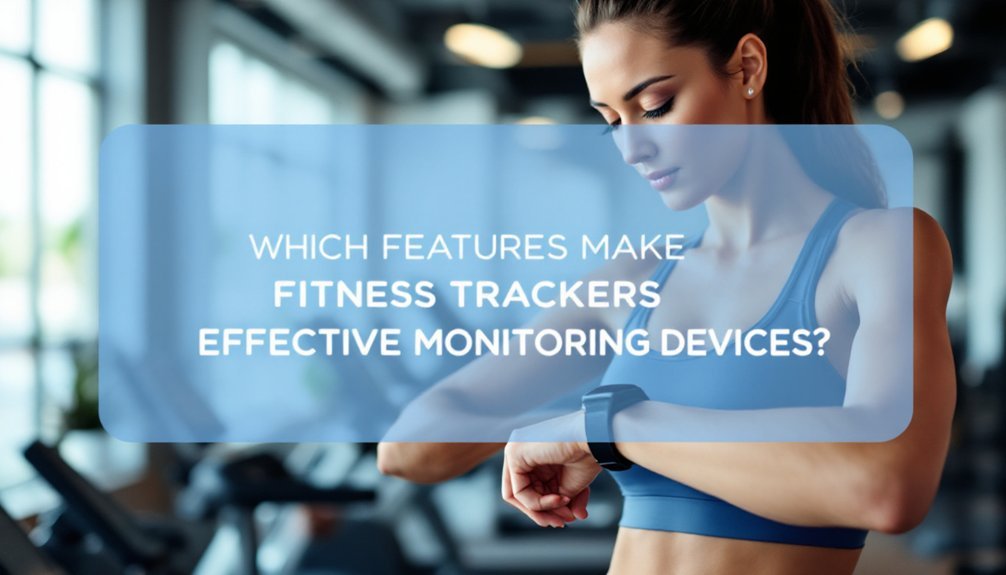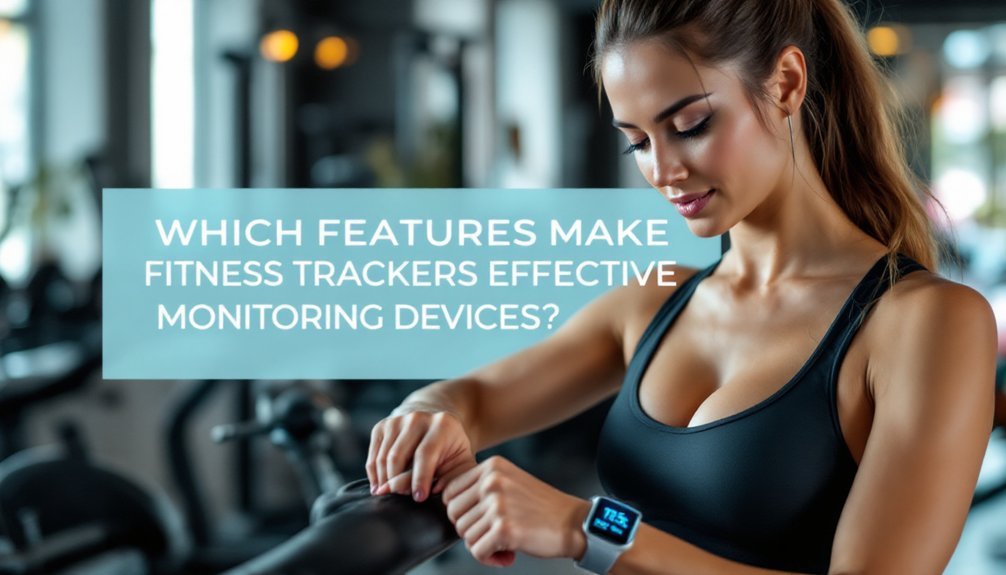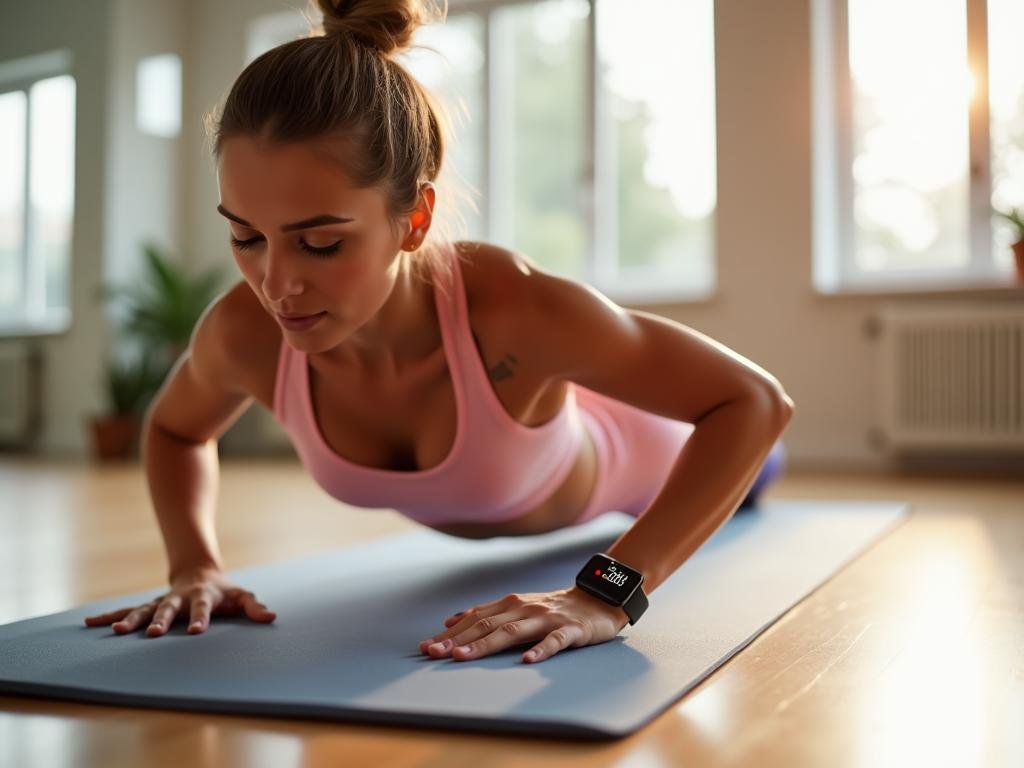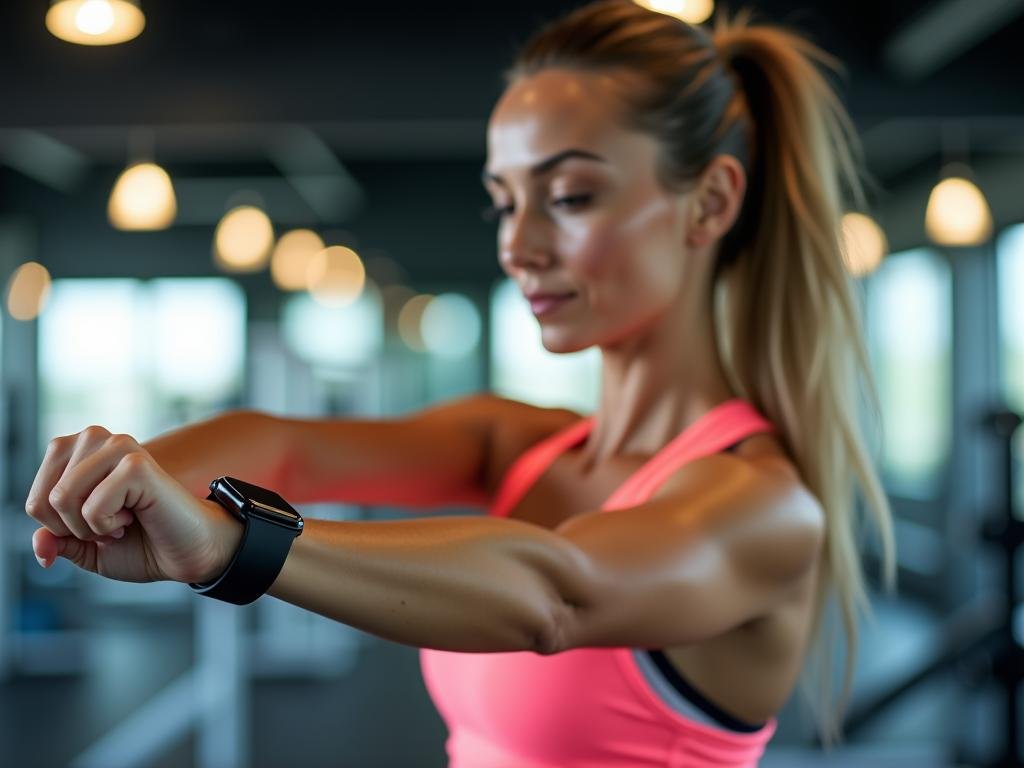Today’s fitness trackers are effective monitoring devices thanks to several key features working together. Your tracker uses advanced sensors to detect movement patterns, heart rate, and sleep cycles while GPS capabilities track your location and speed during outdoor activities. These devices can measure important health metrics like VO2 max, heart rate variability, and body composition through bioelectrical impedance analysis. Real-time performance data helps you understand exercise intensity and recovery needs, while AI-powered analysis provides personalized insights. Modern trackers achieve up to 98.8% accuracy in physiological measurements, making them reliable tools for monitoring your daily health and fitness goals. Let’s explore how these technologies work together to enhance your wellness journey.
Key Takeaways
- Multi-sensor integration combines heart rate, GPS, and motion tracking for comprehensive activity monitoring and accurate health data collection.
- Advanced algorithms analyze movement patterns and physiological data to provide personalized fitness insights and recommendations.
- Real-time performance tracking offers immediate feedback on exercise intensity, heart rate zones, and recovery metrics.
- Continuous health metric monitoring enables detailed analysis of sleep patterns, recovery, and overall wellness trends.
- Integration with health platforms and apps allows data sharing, long-term tracking, and professional health monitoring capabilities.
Activity Recognition Technology

While activity recognition technology has revolutionized how we track our daily movements, it’s not without limitations. You’ll notice activity classification challenges when you’re walking slowly (under 2 mph) or doing household tasks, as your tracker might miss steps. If you keep your arms still while walking or perform quick sports movements, your device may struggle to accurately count your activity. Recent models have shown significant accuracy improvements in basic physiological data gathering. Additionally, the integration of advanced sensor technologies into fitness trackers has led to more precise movement detection.
Your tracker uses accelerometers to detect motion through electrical signals, working alongside GPS and optical sensors for thorough monitoring. While current technology effectively measures regular walking and basic activities, algorithm improvement strategies are continuously evolving. These updates enhance pattern recognition, particularly for complex movements and varied walking speeds. Scientists are developing better machine learning techniques to address accuracy issues, especially for people with unique walking patterns or during specialized activities.
Heart Rate Monitoring Systems
Your fitness tracker’s heart rate monitoring system uses LED lights and specialized sensors to measure how fast your heart beats throughout the day. Modern wearable devices can track your heart rate with impressive accuracy, though factors like exercise intensity and skin tone may affect the readings. The technology works by shining light through your skin to detect blood flow changes, which your device then translates into real-time heart rate data that you’ll see on your screen. For the most precise measurements, chest strap monitors provide superior accuracy compared to wrist-worn devices. Additionally, maintaining gut health through proper nutrition and supplementation may positively influence your overall fitness and heart health.
Accuracy of Heart Sensors

Most modern fitness trackers rely on optical heart rate sensing technology, which uses light to measure your pulse through photo-plethysmography. Proper sensor calibration and error mitigation are essential, as accuracy can vary based on several factors, including your skin tone and activity level.
You’ll find different levels of accuracy across popular brands. Garmin shows impressive results with only 1.16-1.39% error, while Apple Watch underestimates by about 1.3 beats per minute during exercise. Samsung devices tend to show larger deviations, averaging 7.1 beats under the actual heart rate. Environmental conditions, like room temperature and sensor placement, can also affect your readings. During intense workouts, you might notice less reliable measurements due to motion and compression effects, so it’s important to make sure your device fits properly. High-intensity exercises like cycling and elliptical training can particularly impact measurement accuracy.
Real-Time Rate Monitoring
Real-time heart rate monitoring brings advanced tracking capabilities to your fitness journey through innovative sensor technology. You’ll benefit from instant heart rate variability measurements and real-time feedback that help optimize your workouts and track your overall health. Modern fitness trackers offer seamless data transfer to computers and mobile devices.
| Feature | Benefit |
|---|---|
| Optical Sensors | Accurate blood flow detection |
| Advanced Algorithms | Precise heart rate calculations |
| Water Resistance | Workout in any condition |
Your device’s photo-plethysmography technology uses light to measure blood flow through your skin, while built-in accelerometers track your movement patterns. These sensors work together to provide thorough health data you can access immediately through your smartphone or watch display. With IPX7 water resistance and long battery life of up to 30 hours, you’ll get consistent monitoring during any activity, from swimming to marathon training.
GPS Tracking Capabilities

Your fitness tracker’s GPS capabilities work by communicating with satellites to provide real-time updates about your location, speed, and distance covered during workouts. Through constant signal exchange with multiple satellites, your device can pinpoint your exact position on Earth and track your movements with varying degrees of accuracy depending on factors like speed and environmental conditions. This technology has become particularly valuable for parents seeking safety, as GPS tracking enables them to monitor their children’s whereabouts during outdoor activities. Additionally, the integration of smart tracking devices has revolutionized how users can analyze their fitness data and make informed decisions about their routines. While most modern fitness trackers can measure distances within a reasonable margin of error, you’ll find that different brands have distinct tendencies, with some overestimating distances at slower speeds and others showing more accuracy during faster-paced activities.
Real-Time Location Updates
Thanks to modern GPS technology, fitness trackers can now monitor your precise location and movements with remarkable accuracy. The location accuracy you’ll experience allows for detailed tracking of your routes, distances, and performance metrics in real-time, though it’s important to manage your user privacy settings to control who can access this data.
Your device’s GPS capabilities work alongside other sensors to provide thorough activity monitoring. Wearable sensors collect continuous data about your movements and health metrics. You’ll receive instant feedback about your pace, elevation changes, and distance covered, which you can use to adjust your performance on the go. While GPS tracking can drain your device’s battery quickly, many modern trackers offer various tracking frequencies to help conserve power. You can choose between constant, periodic, or on-demand tracking based on your specific needs and activities.
Distance Tracking Precision
Three core components work together to deliver precise distance tracking in modern fitness devices. The GPS accuracy relies on satellite positioning, integrated sensors, and advanced algorithms that process movement data. Your device combines these elements to provide reliable distance measurement across various terrains and activities. The system triangulates satellite signals to calculate your exact position during workouts.
| Component | Function |
|---|---|
| GPS Module | Tracks exact location coordinates |
| IMU Sensors | Measures motion and orientation |
| Barometer | Detects elevation changes |
| Algorithms | Processes data for accuracy |
The precision of your distance tracking depends on how these components interact. When you’re running or cycling, GPS satellites pinpoint your location while internal sensors verify your movement patterns. This dual verification system guarantees you’ll get accurate readings of your covered distance, helping you maintain consistent training intensity and track progress effectively.
Sleep Pattern Analysis
Ever wonder how fitness trackers monitor your sleep? While they can’t directly measure brain waves like medical sleep studies, these devices use a combination of sensors to estimate your sleep quality and patterns. They track your movement, heart rate, and even your sleep environment factors like room temperature and light exposure.
Your tracker’s technology has become increasingly sophisticated, using multiple data points to analyze different sleep stages. It can detect when you’re in light sleep, deep sleep, or REM sleep through your heart rate variations and movement patterns. Sleep cycles typically repeat every 90 minutes throughout the night. Additionally, some fitness trackers incorporate probiotics and prebiotics to help promote relaxation and improve overall sleep quality. Today’s devices also integrate with smart home systems to optimize your sleeping conditions and can wake you at the ideal moment in your sleep cycle through smart alarm features. While not as precise as medical equipment, they’re becoming more accurate with each technological advancement.
Body Composition Measurements

Modern fitness trackers have revolutionized how we monitor our body composition through sophisticated bioelectrical impedance analysis (BIA) technology. By sending tiny electrical currents through your body, these devices can measure your body fat percentage, muscle mass, and water content with impressive accuracy. Incorporating a healthy diet rich in whole foods and probiotics can further enhance your fitness tracking results, as these elements support optimal body composition and gut health.
You’ll get the most reliable results when using devices that feature hand-to-foot measurements, rather than just foot-to-foot sensors. These thorough readings help you track changes in your body composition over time, giving you insights that go far beyond simple weight measurements. For effective monitoring, you’ll want to take consistent measurements and keep your device properly calibrated. Advanced monitors can store up to 90 days of data for multiple users, making long-term progress tracking easier than ever. This data becomes particularly valuable when you’re working toward specific fitness goals, like building muscle mass or reducing body fat percentage.
Real-Time Performance Data
Real-time performance data from today’s fitness trackers gives you unprecedented insights into your body’s response during workouts. Through continuous heart rate monitoring, you’ll receive real-time feedback about your exercise intensity and recovery status, helping you optimize your training sessions. Your device tracks essential metrics like steps taken, calories burned, and time spent in different heart rate zones. The market for these powerful tracking devices is expected to reach $62 billion by 2025.
Advanced features measure your VO2 max and heart rate variability, providing deeper insights into your cardiovascular fitness and readiness for exercise. You’ll also get performance optimization recommendations based on your recovery metrics, including sleep quality and blood oxygen levels. These data points help prevent overtraining by suggesting appropriate rest periods between workouts. Your tracker integrates this information to create personalized activity goals and training recommendations tailored to your fitness level.
Stress Level Detection

Beyond tracking physical performance, fitness trackers now offer sophisticated stress monitoring capabilities to help you understand your mental well-being. Using advanced emotional tracking algorithms, these devices measure your heart rate variability, skin temperature, and micro-sweat levels throughout the day to detect signs of stress.
Your tracker’s stress feedback mechanisms combine physiological data with your personal input to create an accurate picture of your stress patterns. The technology continuously monitors autonomic arousal signals while accounting for physical activity to avoid false readings during exercise. Though these devices can’t diagnose medical conditions, they’re rigorously tested through controlled stress tests and real-world scenarios to guarantee reliability. You’ll receive real-time alerts about your stress levels, allowing you to take proactive steps when needed.
Workout Mode Diversity
Whether you’re a dedicated athlete or casual exerciser, today’s fitness trackers offer an impressive range of workout modes to match your activities. With over 20+ exercise modes available, these devices provide tailored tracking for virtually any type of physical activity you pursue.
Custom workout modes allow you to monitor specific metrics that matter most for your chosen activity. Here’s what makes these modes particularly effective:
- Specialized tracking for activities like yoga, HIIT, and strength training
- Real-time monitoring of repetitions, intensity, and heart rate
- Precise data collection for unique activities like trail running and rucking
- Customizable metrics to match your specific fitness goals
This diversity in workout modes guarantees you’ll get accurate, relevant data regardless of how you choose to exercise, helping you make informed decisions about your training progression.
Health Metric Integration

Modern fitness trackers excel at seamlessly integrating diverse health metrics into a detailed wellness picture. Through health data sharing, your device can sync with platforms like Apple Health and specialized fitness apps to provide extensive insights about your well-being. You’ll receive detailed measurements of heart rate, calories burned, steps taken, and even advanced metrics like sleep quality and blood pressure.
Wearable integration has revolutionized how you interact with healthcare providers and insurers. Your doctor can remotely monitor your health trends, while insurance companies may offer personalized benefits based on your activity data. Though commercial trackers show promising accuracy when compared to medical-grade devices, they might underestimate some measurements like energy expenditure. This integration of data enables predictive analytics that can help identify potential health issues before they become serious problems.
Sensor Technology Advancements
Revolutionary advancements in sensor technology have transformed today’s fitness trackers into sophisticated health monitoring systems. Modern sensor design incorporates artificial intelligence and flexible materials to track your essential signs with unprecedented accuracy, while wearable innovation continues to expand monitoring capabilities.
Here’s what makes current sensor technology so effective:
- Multi-sensor integration combines heart rate, SpO2, and VO2 max measurements for thorough health tracking
- AI-powered algorithms analyze your data to provide personalized fitness recommendations
- Flexible, stretchable materials enable precise monitoring of glucose levels and blood pressure
- Advanced TUNES technology allows for detailed tracking of muscular contractions and respiratory patterns
These technological improvements have led to a significant increase in accuracy, with some GPS features now up to 10 times more precise than previous generations.
Frequently Asked Questions
How Long Do Fitness Tracker Batteries Typically Last Between Charges?
Like a marathon runner’s stamina, your fitness tracker’s battery longevity varies widely. You’ll find mainstream devices need charging every 2-14 days, while premium models can last up to 40 days between charges.
Are Fitness Trackers Water-Resistant Enough for Swimming and Diving Activities?
You’ll find many fitness trackers offer water resistance and swimming capabilities, with ratings from 5ATM to 10ATM, making them suitable for pool swimming, snorkeling, and even deep-water activities.
Can Fitness Trackers Accurately Monitor Blood Pressure Without Additional Medical Devices?
Like a compass without true north, your fitness tracker can’t deliver accurate blood pressure readings on its own. You’ll need traditional medical devices for reliable measurements and regular calibration.
How Often Should Fitness Tracker Sensors Be Calibrated for Optimal Performance?
You’ll want to calibrate your fitness tracker’s sensors every 2-3 months to maintain ideal sensor accuracy, or sooner if you notice inconsistencies in distance, pace, or step tracking measurements.
Do Fitness Trackers Work Effectively for Wheelchair Users and Adaptive Athletes?
While today’s fitness trackers miss the mark like a lost arrow, they’re not fully adapted for wheelchair users. You’ll find they underestimate energy and heart rates, limiting their wheelchair accessibility and adaptive technology benefits.



